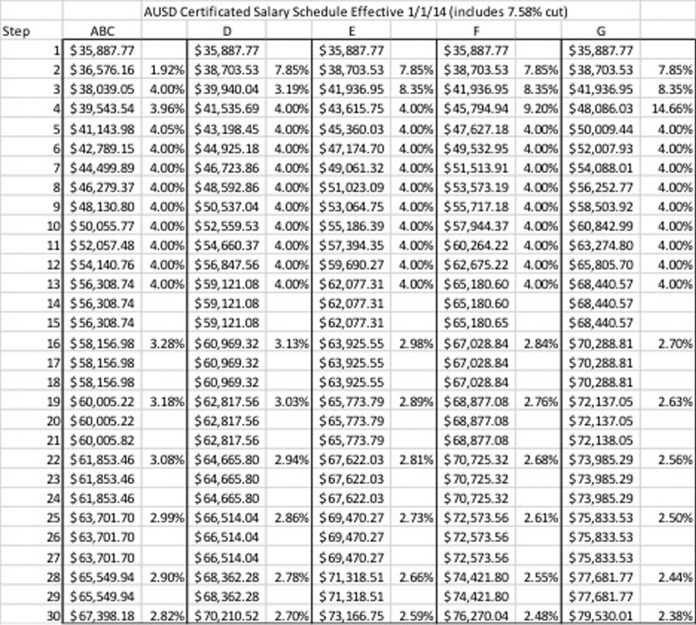Editor’s Note: Even after the Teachers’ Strike is settled, we still have an uphill battle regarding AUSD budgetary deficits. The following report that was published earlier by the Alpine Parent’s Coalition is very insightful as to why the district looked to reduce the teachers’ salaries, and benefits in the first place. For more information, and informational reports, visit our website: www.thealpinesun.com
Editor’s Note: Even after the Teachers’ Strike is settled, we still have an uphill battle regarding AUSD budgetary deficits. The following report that was published earlier by the Alpine Parent’s Coalition is very insightful as to why the district looked to reduce the teachers’ salaries, and benefits in the first place. For more information, and informational reports, visit our website: www.thealpinesun.com
Where is all the money going? Are the Trustees mismanaging the funds? These are common questions that our community is asking these days. The answers are not simple, but there is no evidence that there is any misappropriation of funds. The 2012-2013 fiscal year books are closed and the independent auditor’s report (Wilkinson Hadley King & Co.) is available for download in the January Board Agenda on the district’s website at http://www.alpineschools.net/ausd-trustees-board-policies. There were no recommendations or deficiencies found by the auditor.
The simple fact is that the AUSD is in a declining enrollment, which means that less funds have been flowing into the district from the State. A further, compounding effect has been the reduction in per pupil funding from the State and rising structural costs. Though the State funding has leveled off and is now increasing, the increase in overall funding is not great enough to offset the loss of students and increasing costs. For several years, AUSD has been experiencing a net decrease in total funding.
Increasing Costs
The AUSD budget currently uses $.87 of every dollar to pay for employees and benefits. That leaves $.13 to maintain and insure facilities, and to supply the classrooms. Of that $.13 that is used for these purposes, there is a small portion that is actually discretionary. Most of the funds are tied to contractual obligations (labor) or operating necessities. The margin for “mismanagement” of funds is a moot argument.
Structural Costs Increases – Labor
Certificated (teachers) and Classified (support) Staff have labor agreements that stipulate salary increases that are based on longevity (years of service) and/or professional development. This is known as “Step and Column”. In the case of the AUSD Certificated Staff, a new teacher starts at a base annual salary of $35,887. For each year of service, from years 1 through 13, that teacher is granted a step increase on an annual basis. For years 13-30, teachers are granted a step increase every 3 years. After 30 years, there are no more step increases; the salary remains flat. During his/her tenure, a teacher may jump to a different column, a column that awards a higher salary for advanced educational degrees.
The Step and Column methodology is not unique to Alpine. It is used frequently in many public agencies. A similar model is used for AUSD’s Classified employees. These “built in” increasing costs are not the basis of the problem. They are a contributing factor to rising costs that needs to be clearly understood in the context of the bigger picture.
Not all teachers at the same step earn the same salary. As you look at the salary schedule in the table below, you will note that the Column A/B/C has a lower top end than the other column. The Step and Column rewards teachers for pursuing higher education.
Step and Column increases are not “raises”. They are not subject to cuts or freezes. They are embedded into the fabric of the labor contract. Therefore, any cut that is imposed, is imposed at the schedule of salaries, but there is no cessation of movement up the step or through the columns (these costs have never been frozen). For example, a hypothetical teacher at Step 10/ Column E makes a base salary of $55,186. If the AUSD imposes a salary cut of 7%, the entire table is replaced with a new one that is reduced by 7% across the board. Teachers remain at their respective step positions on the new schedule. In our example, the teacher is still eligible for a step increase of 4% (step 10 to step 11).
On the other hand, a teacher that is at 30 years of tenure or more is no longer eligible for step increases. Thus with any cut, there is no opportunity for restoration of income without a restoration to the schedule. The implication of the current round of cuts varies significantly from teacher to teacher, based on where the teacher falls in the schedule. Based on the data provided by AUSD, there are currently 9 teachers that are no longer eligible for longevity/step increases. Some of these teachers’ salaries have effectively been frozen for years.
These salaries represent the base salaries only, and do not include the particular health and welfare (H&W) benefit chosen by each AUSD employee. Prior to the imposed $8,000 cap, the H&W benefits ranged from $1,000 per year to $19,603 per year, with an average overall benefit per teacher (per the Fact Finder’s Report) of $13,700 per year.
For the purposes of analyzing cost in AUSD, we have loaded a “scattergram” of the all of the teachers in the AUSD. The data in the scattergram represents the current salary of each of our teachers, including the recent 7.58% cut. Each data point on the scattergram represents one teacher, and the actual associated salary is indicated on the left side of the chart. The data points are color-coded to show where the AUSD teachers actually are in each of the five columns of the above table salary schedule. Please note: we are not using average or theoretical data. The data is the actual salary schedule data from AUSD.
APC has not used any of the ranking data that has been handed out by California Teachers Association “CTA” to teachers and parents because the data is so qualified that it does not represent the challenges that our tenured payroll presents. For example, one sheet was passed out that ranks the AUSD at the bottom of the “lowest entry salary”.
The relative ranking of entry level pay is irrelevant in our current crisis.
We do not have entry level teachers! In fact our payroll is substantially higher due to the tenure. We have to manage our schools based on the real numbers, and we have to create solutions that are based on that reality!
We are fortunate to have a highly tenured teaching staff in AUSD, as reflected by high concentration of data points in the upper regions of the scattergram. We should be embracing our tenure, not ignoring that we have to manage the related challenges.
Each dot/data point represents one teacher. The bulk of data points in the upper regions clearly show that our AUSD teachers are a tenured workforce. Furthermore, the high concentration of red data points illustrates a highly educated workforce. With that tenure and education level, comes the responsibility to recognize the payroll implications by our workforce, Trustees and our community so that we can manage it.
The data points that are shown as triangle-shaped represent part-time positions. Part-time positions (50-50 contracts) are eligible for full health and welfare benefits. The top health and welfare benefit offered and paid 100% by AUSD in 2013 was $19,603 (November, 2013 Board Presentation of Benefit Selection). The current cut (from the maximum to the new $8,000 cap) will be a disproportionate cut to the overall compensation of the people generally at the bottom of the scattergram – as these are the individual employees whose health and welfare benefits represent a large percentage of their total compensation.
Next, we took the teachers’ Step and Column data and ran a list of associated gross payroll (see the table below). Each color in the table represents in which column the teachers are located. Within the color band, movement to the right represents an advancement to their next step (we ran 2013-2016). Remember, not all steps are associated with a cost increase, so some numbers will remain the same for 3 years, then change in the fourth year.
We advanced the current workforce through the steps to examine the cost impact on an annual basis (moving left to right through the table). This analysis is not a criticism, but is designed to show us what to expect under these contractual conditions. This model is designed solely to get a true understanding of the structural issues that we face in the case of flat or declining revenue models.
The analysis can also be used to gain an understanding of the revenue growth that is required in order to simply maintain the “status quo”. That is, what does it cost to pay for the increase in annual contractual obligations? We are a tenured District and we need to find ways to financially support our teachers.
The following full page table presents Certified Staff Step/Longevity annual cost projections for each current teacher projecting from 2013 through 2016 (actual gross salary reflecting the January, 2014 7.58% cut.
As you examine the salary structure, you will see that the advancement of just the teachers through one year will cost an additional $67,187 (denoted in yellow). This is the salary only and does not include the workers’ comp insurance, retirement, or employer payroll taxes associated with an employee (this adds 11.36% to the gross payroll cost for the AUSD for this year). District-paid Health & Welfare Benefits “H&W” are excluded too. To show how this contractual arrangement affects AUSD, let’s roll through a few years under the basic assumption that revenue is neutral; e.g. there will be no loss of students and no decrease in funding.
At the end of year one, the district is faced with the additional cost of $67,187 (denoted in yellow). That creates a decision point. Cut one teacher, cut the expense somewhere in the operations, or spend the reserve (remember, we have flat revenue in this model). If you cut the teacher, the class size will be increased (albeit small).
Now, advance through year 2, and you have the same condition again, with a contract-mandated $71,325 increase (denoted in orange). You have a rise in costs and you have another decision point. If you want to balance the budget, then you must make a cut. If you lay off a teacher or staff, then you get a reduction in service.
If you do not cut and decide instead to spend from the reserve, each successive year carries that cost forward, and the overspending is compounded. So, the imbalance of carrying costs for the three years in the model results in a deficit of $171,162 ($67,187 + $71,325 + $32,648). This deficit will continue to grow unless your revenue is growing. Additionally, our model is not accounting for any movement/advancement of teachers across the column structure.
Our model above is based on movement from one step to the next. The district has calculated that for this current school year, 36 of the 89 certificated employees returning from 2012-13 advanced on the salary schedule for longevity and/or education for a total increased cost of $89,232 in wages, plus $10,137 in statutory benefits for a total cost of $99,369!
From the above examples, you get a perspective of what a “structural” deficit looks like. Let’s expand the discussion to include:
•Similar cost increases (albeit smaller than the teachers’ in gross dollars) of certificated staff and administration.
•Increasing costs of H&W insurance benefits (until the recent cap, 100% of insurance costs for a qualified AUSD teacher and family was absorbed by the AUSD budget. Our analyses showed that this cost was compounding at approximately $80,000 per year (almost 1 teacher would need to be cut in order to sustain this growth alone in a flat revenue model).
•Increasing cost of supplies
•Let’s now consider that per-pupil revenue is not flat, that for a period of years, the per-pupil revenue from the State was reduced.
•Finally, let’s consider that the number of kids coming to AUSD drops annually.
Each of the conditions above created a situation whereby pressures to reduce costs created a conflict between the Trustees and the workforce. This has been the condition in AUSD for the past 5 years, and as our discussion of revenue showed (see Exhibit – Revenue History on the APC website at http://alpineparentscoalition.com/), all the mechanisms that were employed to sustain spending are exhausted!
This problem is not the making of a single decision – though it can be exacerbated by individual decisions. It is a matter of economic, demographic, contractual circumstance that we are facing. Cuts are necessary for financial survival today, but the cuts are not the solution that we need to work toward. The solution must be found in revenue generation. We cannot rely solely on the State to increase funding!
We have to generate revenue by creating a draw to our schools.
AUSD has seen enrollments decline for the past 10 years (see our Exhibit – Enrollment on our APC web page at http://alpineparentscoalition.com/).
It was believed that a high school would be built in the community by the Grossmont Union High School District (our children are part of a high school district that is separate from the Alpine Union School District – AUSD includes kindergarten through 8th grade only). Without hope for a local high school, it is unknown what the effect will be on Alpine, but it can certainly be stated that families choose to move to communities based on having schools. It has been argued by many that had there been no chance of a high school, their home purchase decisions would have been different, so we have to consider this factor as we move forward.
So what can we do? We can continue to support our Alpine Union School District as a whole. We can treat ALL members of the District and each other with civility and understanding. We can work towards our common goal of generating more income for our school district. We can keep our kids in our district, encourage others to come to our district, and work hard to build up the programs offered in our district, even if that means volunteering our own time or money to make that happen.
The Alpine Parents Coalition is looking for anyone that is interested in improving AUSD. We are proposing the formation of four committees: A Budget Committee comprised of Parents, Staff and Teachers that will meet monthly to discuss the financial developments as they relate to our schools- we don’t ever want to see the current level of discourse again; An Exit Interview Committee comprised of Parents that will interview the parents of children that are leaving the AUSD and report finding to our Trustees quarterly – this is not a retention group as these parents cannot be expected to resolve structural issues that are the responsibility of the Trustees; a Unification Committee comprised of Parents, Teachers, and Administration to discuss the impact of potential unification on our community; and a Marketing Committee that actively promotes the great programs that are in the employ of our teachers and that have somehow been lost in our community messaging. Visit us at www.alpineparentscoalition.com . Email us at alpineparentscoalition@gmail.com . We are mostly a group of working parents, so please be patient with us in our responses to you.













